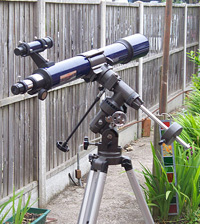
On the other hand, many people dabble in amateur astronomy, then give it up almost at once. Why should this be? One reason is that what you can see from your backyard does not measure up to the amazing photos taken at major observatories or from space. Another is that a lot of the equipment sold to amateurs is neither of good quality nor particularly suitable. The sorry fact is that good quality astronomical equipment varies in cost between expensive and eye-wateringly expensive, and many telescopes or “starter scopes” are sold on the basis of cheapness. Starter-scope mountings, for instance, are almost always too wobbly.
Several of the desirable qualities of a telescope (performance, cost, size, ease of use) conflict with each other. So how are you, as a vaguely interested person, to navigate your way through this minefield? Possibly not by visiting a telescope store, where you will be confronted by telescopes of all shapes, sizes, designs and prices. Think about what you want the telescope to do, and how much you are prepared to spend. Less than £100? Same price as a new i-pad or smartphone? Same price as a used car? Any optical aid for looking at the night sky is a lot better than none, but with the cruder instruments you will soon run out of interesting objects to view.
How are you going to use it? Most likely, keep it indoors and haul it outside on a clear night. That imposes constraints on size and weight. How much time are you prepared to spend setting up the thing every time you use it? If the answer is “two minutes” you might be wasting your money on one of the more sophisticated mountings.
The mounting, you say? That’s another specialist, and potentially expensive subject, which I’ll return to later.
Where do you live? If like most of us, you live in a town, you can still discover many objects in the night sky, but you will be looking at small bright objects rather than extended dim ones, which has a bearing on your choice of telescope.
Of the designs commonly available the ‘refractor’ conforms most closely to the layman’s idea of what a telescope looks like. In small sizes (under 100mm aperture) these are the obvious choice, but as size increases they become expensive, then eye-wateringly expensive and too long and heavy to be carried. Then there is the Newtonian, which has a mirror at the bottom of the tube and an eyepiece at the top on one side. The prime advantage of these is that, size for size (aperture), these are the cheapest of all the designs, and less bulky and heavy than a refractor.
The ‘Maksutov’ is a modern design which uses both lenses and mirrors to form a very short telescope with an eyepiece at the back. Despite its looks, this like the refractor, is a ‘long focus’ telescope suitable for looking at small bright objects. The compact form makes it very convenient for keeping indoors and hauling out on a clear evening, or even transporting by car.
Be wary of the various ‘short focus’ designs, as these are more of a specialist scope for astrophotography or looking at wide starfields, and are more prone to optical problems than the ‘long focus’ designs.
Mountings – the ‘alt-azimuth’ mounting is one whose function the layman will at once understand, as it allows the telescope to be pointed up and down and from side to side. It is also quick to set up. The ‘equatorial’ is tilted over to align with the earth’s axis, so that to compensate for the earth’s rotation the telescope only needs to be moved on one axis, (an action which can be motorised). Once you have tried observing for yourself, the advantage will be obvious, and it is also essential for long-exposure photography.
Both varieties of mounting are now available with electronic assistance in the form of built-in computers and motors which allow you to find objects by selecting them from a list on the handset, typing in their co-ordinates, or even clicking on a list on your laptop. This is a great advance allowing you quickly to locate objects invisible to the naked eye. All models will track objects once found. You can even find planets in broad daylight. If you can afford such a system, why would you settle for less? Why put up with the frustration of being unable to find objects that are not bright and obvious? The downside is the increased setup time, and for computerised heavy-duty equatorial mounts, the cost.
If you can afford one, I would recommend a ‘Maksutov’ telescope on an alt-azimuth electronic computerised mounting as your starter scope. Examples are available for under £400, which might seem expensive compared with some of the scopes available. But in terms of “astronomical objects viewable per pound (or dollar) spent” it is better value than apparently cheaper telescope kits, and in this price range you will bypass much of the rubbish.
An expert’s view
Moving on
Once you have your first scope, what next? An 8 inch Newtonian on a EQ-5 mounting seems a popular purchase, judging by the numbers of new and used kits on offer. An 8″ Newtonian is a lot of telescope for the money and the EQ-5 mounting is a good rigid one. I would not recommend this as a first purchase lest you find that it’s too big to handle and after the first flush of enthusiasm has worn off you can’t find much to look at (without a costly computerised mounting). If you got the basic manual mount, a tracking motor is around £85 and a full computerising kit another £300. Pointed in the right direction, an 8″ should show more detail on planets and fainter deep-space objects than a smaller instrument. With a solid equatorial mounting, ventures into photography are a possibility.
